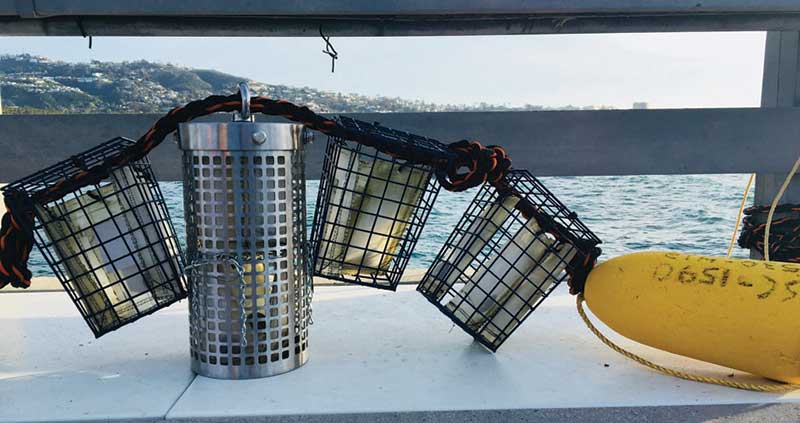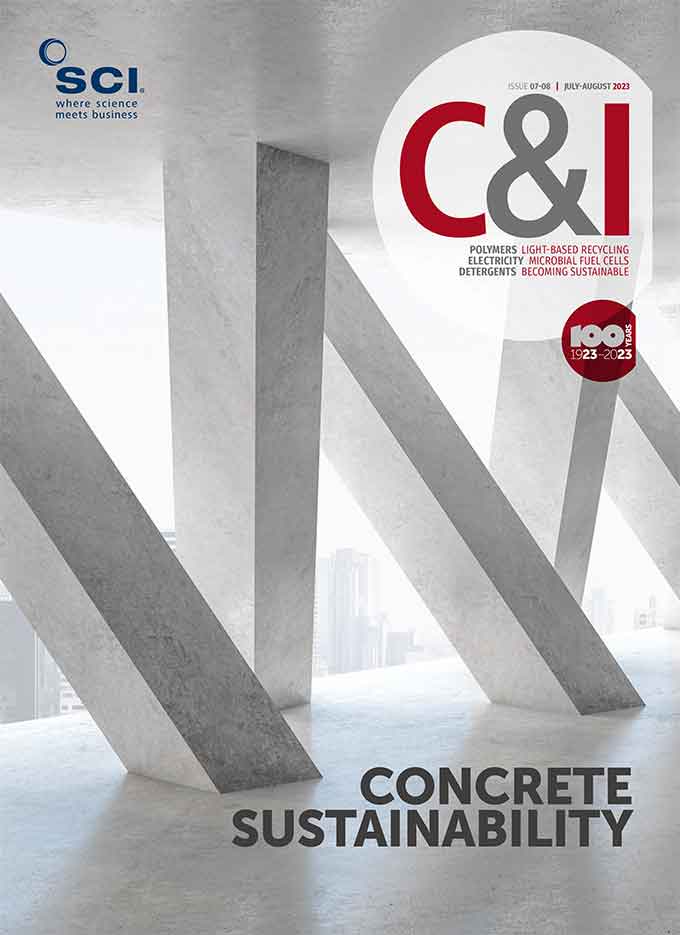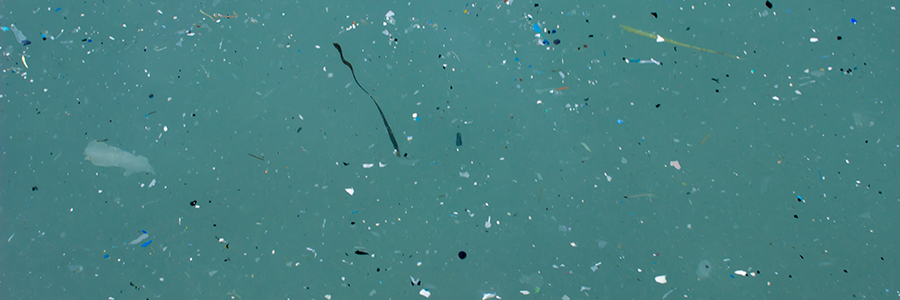Lucy Wright
The volume of plastic waste generated from the fast fashion industry has been declared an ‘environmental and social emergency’ for the planet by the United Nations.
While biodegradable plastic materials have been marketed as potential solutions to the problem, new research has shown that this is no guarantee the fibres will decompose at the end of their life.
For the first time, researchers at UC San Diego’s Scripps Institution of Oceanography, US, have tracked the ability of natural, synthetic and blended fabrics to biodegrade in the ocean – where large portions of plastic textiles commonly end up.

Image right: Deploying the cages
Credit: Sarah-Jeanne Royer
The findings speak to a need for standardised testing to ensure that products commonly labelled as compostable or biodegradable do actually biodegrade in a natural setting. Sarah-Jeanne Royer, lead author of the study, noted: ‘What might biodegrade in an industrial setting does not necessarily biodegrade in the natural environment, and can end up as marine and environmental pollutants.’
To those working at the forefront of tackling textile waste, these findings will not be unexpected. Richard Blackburn, Professor of sustainable materials at the University of Leeds, UK, and co-founder of the non-profit group Reducing the Impact of Textiles on the Environment, said: ‘It’s no surprise these bio-based plastics don’t biodegrade, they’re not designed to do that. They can be composted in industrial composting facilities with high microbe content at high temperatures (around 70°C), but these have no resemblance to the environmental conditions of the ocean.’
While Royer and the team found that natural cellulose fabrics in the ocean degraded within a month, Blackburn notes that these were virgin fibres with no chemical processing. ‘Once such fibres have been through all the various processes to make textiles (scouring, bleaching, mercerising, dyeing, finishing, etc.), they don’t degrade easily, as nature doesn’t recognise them – they’ve been chemically modified so much.

Degradation of materials recorded over time. Credit: Iyvonne Khoo
‘Consumers need to educate themselves to make sustainable choices, as information provided can often be misleading or incorrect. Don’t rely on brands to provide thoroughly researched information, as few of them do the research and work with universities to really understand the issues.’
Royer agrees that consumers should be mindful of the materials they are buying. She said: ‘We should all aim to buy fewer garments, opt for high-quality, cellulose-based materials like cotton, merino or wool that will last longer, or look to more circular and sustainable options that repurpose items like clothing swaps and Buy Nothing groups.’
The research coincides with the United Nations Environment Programme’s (UNEP) release of a report during the World Circular Economy Forum 2023 in Helsinki, Finland. UNEP says the report offers a roadmap for ‘transforming the textile value chain into one that is sustainable and circular and will allow the environmental and social impacts to be addressed’.

Cage design used for the sea surface experiment that took place off the Ellen Browning Scripps Memorial Pier at Scripps Institution of Oceanography in 2019.
Credit: Sarah-Jeanne Royer
Recycling the issue
In other news, an international team of researchers have called for improvements in plastic recycling. In a pilot study (Journal of Hazardous Materials Advances, doi: 10.1016/j.hazadv.2023.100309), the team estimated that between 59 and 1,184 tonnes of microplastics may be discharged annually from recycling centres.
The authors took samples from recycling wash water discharged from a mixed plastics recycling facility in the UK. They found that, while filtration systems installed at the plant were generally effective at removing larger microplastics, particles smaller than 5µm were generally not extracted, resulting in high levels in the discharged water.
Erina Brown, from the University of Strathclyde in Glasgow, UK, the lead author of the study, stressed the importance of the research in addressing a critical knowledge gap. ‘There seemed to be a huge gap in research into the potential for plastic recycling facilities to act as a source of microplastic pollution, with, at the time of our research, only two studies published globally – both looking at particles much larger than we looked to.’
The small size of the microplastics found in the discharge water is of particular concern, for both the environment and human health. Brown explained:
‘Microplastics have been found in a huge range of organisms, from large marine birds to zooplankton. This is a very rapidly advancing field of research as we become more and more aware of the microplastic pollution problem around the globe.
‘Some of these particles pass through digestion systems and are excreted, yet many (and increasing amounts, the smaller the particle) can be transported around the body and can accumulate. Nanoplastics, the newly named category of plastic particles smaller than 1µm, have been found in humans, in places such as human blood, placenta serum and breast milk. This is not all new research, studies published in the 1990s have shown increased cases of interstitial lung disease in workers working in factories inhaling microplastics.’
Speaking at a recent SCItalk, Tristan Kaye, the Commercial Director at Notpla, an Earthshot prize-winning start-up making sustainable packaging from seaweed, commented on the study: ‘Recycling is not the holy grail that sometimes it is being held up to be.’ He stressed that ‘a set of multifaceted solutions’ are needed to combat the prevalence of plastics in the environment.
Filtration, regulation, innovation
The study recommends that additional filtration is needed in recycling centres to remove smaller particles, and water quality regulations should integrate microplastics into their policies.
‘Microplastics currently have no mention in the regulation of water quality. As plastic recycling facilities can be considered point-sources of any potential pollution, there are extensive regulation frameworks, which this could be woven into. We need to integrate microplastics into the control of water quality, as many countries already do for the regulation of, for example, organic contents in water.’ explained Brown.
Richard Lampitt, who leads the Microplastic Research Team at the National Oceanography Centre, agrees. He said: ‘There are no UK regulations in place to restrict the pollution load, which can be released into the environment in terms of plastic. This is a failing in UK policy and should, in my view, be rectified not only in terms of the weight of plastic that can be released but also its characteristics in terms of particle size and the concentration of additives such as colourings, flame retardants and plasticisers, which are often the chemicals which cause the most harm.’

Richard Lampitt, photographed at SCI's 2023 AGM, is the grandson of Leslie Lampitt, after whom the Lampitt Medal was established in 1958.
However, Brown does not think that regulations alone will go far enough. ‘The real solution is tackling the problem upstream. We need a global massive reduction in plastic production and consumption and international decisions and policies must be made and committed to in order to do so.’
In more positive news for plastic recycling, a Danish trio of partners is developing super-high-resolution, hyperspectral cameras that can determine the chemical composition of plastic waste and the different additives.
The project, a collaboration between Aarhus University, the University of Southern Denmark and the company Newtec Engineering, hopes to reform the recycling process by achieving a spectral resolution high enough for the camera to reveal unwanted fire retardants and pigments in plastics.
Mogens Hinge, from the Department of Biological and Chemical Engineering at Aarhus University and lead researcher on the project, noted: ‘It’s an extremely ambitious goal for this camera technology, and it places strict demands on the optical components. Besides a uniquely high resolution, we’re also aiming to optimise the camera optics for light spectra that are crucial for analysing plastics.’
Hinge and the team hope that the research will help to ‘push the boundaries’ of plastic recycling.






